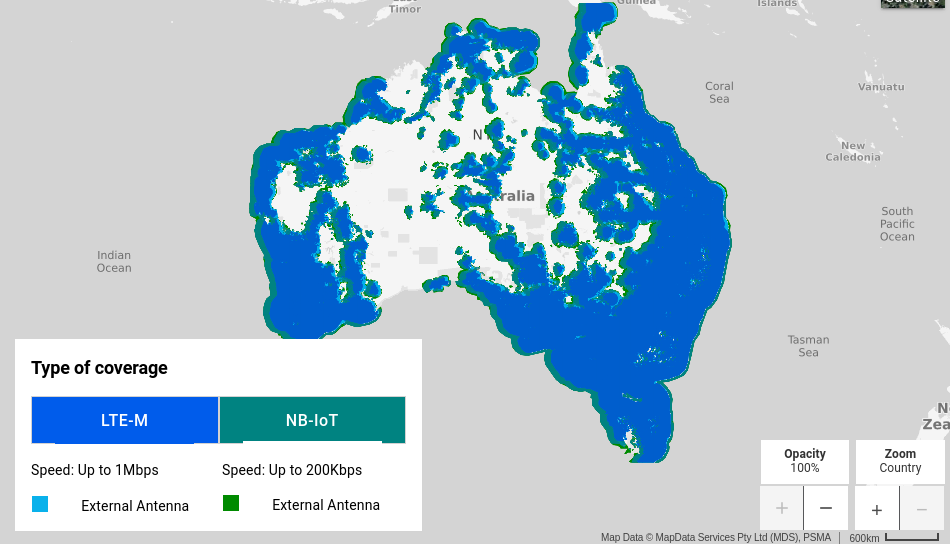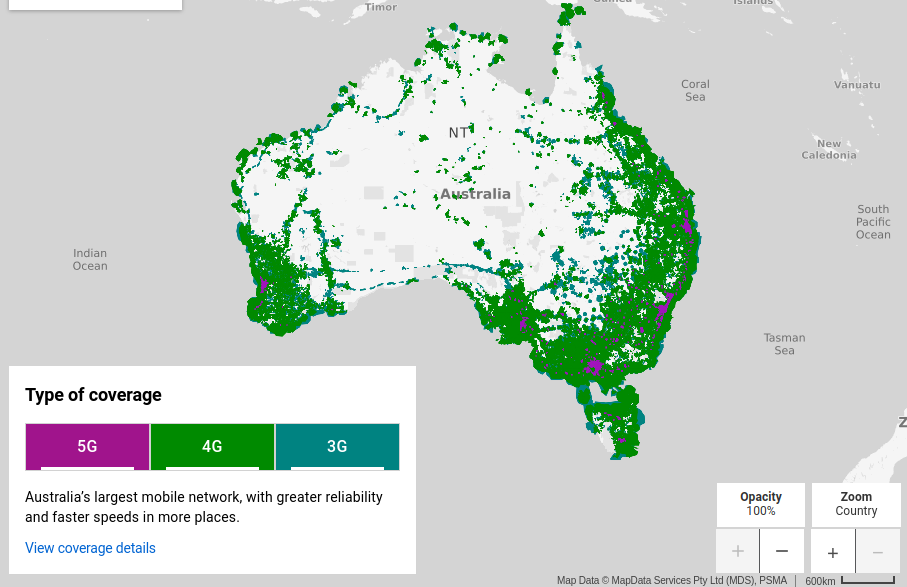3G (3rd generation mobile technology) networks for the major telecommunication companies are due to shut down over the next few years. This includes Telstra, whose network is now in the sunset phase and due to close in June 2024.
This will mean the end of 3G for Internet of Things deployments, and they will need to migrate to either LPWAN (Low-Power, Wide-Area Networks) or new generation cellular mobile, depending on the use case.
As pointed out in this article on Why you need to migrate your devices now! that does not give a lot of time. If you have 15,000 devices in the field you need to be replacing 30 devices per day — if you start tomorrow; more if you take long to commence your project.
The are three main options for migration, in two categories:
- LPWAN
- NB-IoT (Narrow-Band Internet-of-Things)
- Cat-M1 (Category M1), also known as LTE-M (Long Term Evolution, Category M)
- Cellular Mobile
- 4G LTE (4th Generation) mobile
This post will explore those options in a bit more detail, as well as what other alternatives there might be. 5G NR (5th Generation New Radio) does not yet have wide enough coverage to be a viable option for IoT in most cases.
If this seems a bit overwhelming, given the short time frames and what you need to do, then you can also approach our consulting services, Telstra Purple, for advice and help.
Radio networks
While there is a lot of technical caveats, broadly speaking Telstra operates five (5) separate cellular radio networks in Australia, with other carriers offering similar options.
The 3G network is in sunset phase and will be decommissioned in the near future. The other four radio networks are NB-IoT, Cat-M1, 4G LTE, and 5G NR, and depending on which one you choose, you will need different hardware and devices. Coverage maps for each of the five networks are given below.
The technical situation is a bit more complex than that, for example many devices, such as cellular handsets, will do both 4G LTE and 5G NR, and many IoT devices support both NB-IoT and Cat-M1. And within any one category there may be different levels of capability — for example a 5G NR device for North American that operates on 1900 MHz won't work on Telstra's 850 MHz or Optus' 2300 MHz. Or that current 5G NR deployments often use a base 4G LTE carrier.
Many of the terms are also muddled by marketing, rather than having a specific technical definition.
But broadly speaking you will need to pick the radio network that fits your use case, and then update to corresponding devices.
The options are divided into two broad categories.
- LPWAN: NB-IoT and Cat-M1 are both low-power, wide-area networks. These technologies have large coverage areas and low power usage, but also low data rates.
- Standard cellular mobile: Standard 4G LTE and 5G NR, as used in smart phones, offers much higher data rates, but lower coverage and higher power usage. These suite use cases where higher bandwidth is important, such as video, and where power is readily available.
NB-IoT and Cat-M1 (two radio networks)
NB-IoT and Cat-M1 are now part of the 5th generation (5G) standards as while they were originally created as part of 4G they meet the requires for 5G low-power, wide-area network use cases.
The coverage of NB-IoT and Cat-M1 is greater even than 3G deployments, so even areas that don't receive mobile phone signals may still be suitable for LPWAN deployments. Below is the coverage map in early 2022; for an updated map see the Telstra IoT Coverage Map.

The main difference is that NB-IoT offers wider coverage and better penetration than Cat-M1, but does not support cellular hand off so is better for fixed assets. Cat-M1 supports mobile assets and has slightly higher data rates, but less coverage.
The Why you need to migrate article lists these as separate use cases, but many devices support both radio standards and can be used for either. The newer iterations of the standards also start to blur the lines with mobile versions of NB-IoT.
Both technologies offer similar overall power usage as the higher power usage of Cat-M1 is offset by the higher bandwidth and less time needed to send data; NB-IoT uses has lower power usage but needs to keep the radio on for longer.
In low usage scenarios, waking to collect data every 15 minutes or longer, and transmitting burst data once a day (with alerts transmitted as needed), battery powered devices can last up to many years in the field.
A proper site survey is needed for any remote deployments.
LPWAN use cases
LPWAN is well suited for many IoT applications where broad coverage is required, but low data usage, and with long lived battery powered devices such as agriculture and metering. The ability for NB-IoT to penetrate sub-surface can be useful for deployments in hard to reach locations.
- Agricultural monitoring
- Industrial sensors
- Water and gas metering
- Environmental monitoring
- Smart venues
- Smart buildings
- Asset tracking
- Smart cities
- Wearables
Cat-M1 is useful for other lower power use cases such as asset tracking or where higher bandwidth is required than provided by NB-IoT.
These technologies also have applicability for commercial usage in environment monitoring where an independent network is required.
For example to implement temperature monitoring in a climate controlled warehouse it might be appealing to use existing hard wired power and network connections, however if there is a catastrophic failure then you monitoring will go down along with the climate control. Deploying battery backed LPWAN devices provides an independent monitoring solution that will continue to function even if the location loses power and fixed network connectivity.
Telstra offers a range of deployment-ready Captis monitoring devices that support their IoT network, as well as flexible IoT data plans to suite your needs.
IoT technical considerations
NB-IoT and Cat-M1 both offer direct IP connectivity, which can simplify communication.
Many IoT devices only support IPv4, although IPv6 is available where appropriate, avoiding the need for private address ranges and network address translation, and providing end-to-end connectivity, but at the cost of larger addressing overhead.
Telstra has extensive experience with IPv6 and has successfully converted the majority of it's consumer mobile network to single stack IPv6, without disruption, and transparently to regular users.
However, when connecting IoT devices to upstream cloud platforms, just because you have direct IP connectivity, and the devices may be capable of connecting directly to platforms, that may not always be the best choice.
Many of the cloud platforms, e.g. Azure IoT, use a verbose protocol, with large amounts of overhead, and while a device may be capable of connecting, doing so would quickly reduce battery life.
It is usually far better to use a lightweight protocol, such as Lightweight Machine to Machine (LwM2M) or a condensed form of MQTT to connect to a gateway, and then have that gateway talk the more verbose protocols to the cloud platforms.
Similar considerations are needed in many IoT use cases where you can't assume unlimited power, processing capability, or network bandwidth, and have to optimise for highly constrained embedded systems.
Alternative low power technologies
There are several alternative (non-cellular) technologies available for low-power, wide-area network scenarios.
These include LoRaWAN, Sigfox, and in some cases satellite, each with different benefits and trade offs.
For example with LoRaWAN while it may provide range, you may need to provide your own base station infrastructure (which can in some cases be a benefit), if a public provider is not available in the area.
Or while satellite can provide unparalleled coverage, transmission may require significant power compared to terrestrial solutions.
For short range operations there are also low power options such as Bluetooth low energy (BLE), Zigbee (a mostly consumer focused technology), and 6LoWPAN. While low power, all of these also require appropriate base stations with back haul over NBN or another internet connection.
3G, 4G and 5G (three radio networks)
Currently only 4G LTE is a viable option to replace existing 3G deployments, with the 4G LTE network now being almost as wide spread as the retiring 3G. 5G NR has very limited coverage areas and so only currently usable in major population centres.
Below is the coverage map from early 2022. For an updated map see the Telstra Mobile Coverage Map.

One of the drivers for the 3G shutdown is the expansion of the 5G NR network, as once the radio bands are freed up they can be reused to extend 5G NR.
Many devices can support both 4G LTE and 5G NR, similar to mobile handsets.
Cellular mobile provides lower coverage than the LPWAN technologies, but much higher bandwidth, capable of supporting video, tablet devices, and similar use cases. Consumer mobiles run on the 4G LTE (and 5G NR) networks.
Future 6G, planned for rollout in 2030, will provide even greater bandwidth.
Cellular mobile also has greater power consumption than LPWAN, and so either requires a power source or regular recharging of devices.
Mobile cellular use cases
Cellular mobile (4G LTE and 5G NR) support high bandwidth scenarios, including video streaming, tablet devices, and similar scenarios where power, or recharging, is readily available.
- Connected home
- Telematics and vehicle monitoring
- Remote healthcare
- Home appliances
- Video security
- Mobile phones
- Remote critical robotics
- Critical security
- Autonomous vehicles
- Racing manned flying electric cars
4G LTE can also provide a back haul capability for low power deployments. For example you could deploy LoRaWAN devices or Bluetooth low energy, and have them connect to a local central powered gateway that then uses 4G LTE for the upstream connection (for where power, but not network, connectivity is available).
Where there is no existing 4G LTE coverage, such as remote sites, private LTE networks can be deployed to provide coverage for both IoT use case and cellular mobile.
Alternative high bandwidth technologies
Alternatives to 4G LTE and 5G NR are NBN or other fixed networks, and WiFi. These can be suitable for installation in limited areas, but generally don't suit mobile usage such as asset tracking.
You can also deploy mixed solutions, such as Bluetooth low energy devices connecting to a fixed Internet gateway, with battery and 4G LTE backup.
Next steps for your 3G devices
If you have an existing fleet of 3G devices you will need to replace them before the networks shut down over the next few years.
This will require planning and lead time to acquire and test new devices, and for rollout, so you need to start the journey soon.
The first step is to survey your existing 3G fleet and see which use cases are needed for the future — do you have high bandwidth use cases such as tablet devices and video that will require a 4G LTE solution, or do you have low-power, wide-area network requirements such as metering, monitoring, and asset tracking, that will require NB-IoT and Cat-M1 solutions.
Hopefully this post has helped you understand the differences between the two main uses cases and decide which is appropriate.
For each of your use case you will then need to find appropriate replacement sensors and devices. In some cases you may be able to reuse existing sensors and just replace the modems or communication devices.
Then pick a pilot project and start implementing before time runs out. You don't want to be caught in the last minute rush, or worse be left without a replacement when the 3G network shuts down.
